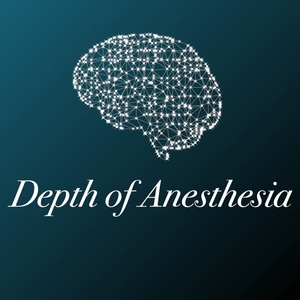
17: Is it important to reverse to a train-of-four target of 90%? - Part 2 of 2
Depth of Anesthesia09/09/20 • 41 min
In this part II or II series on neuromuscular blockade, we investigate the claim that a train-of-four target of 90% is important to achieve prior to extubation.
Our guest today is Dr. Daniel Saddawi-Konefka, residency program director at Mass General.
Connect with us @DepthAnesthesia on Twitter or email us at [email protected].
Thanks for listening! Please rate us on iTunes and share with your colleagues.
Music by Stephen Campbell, MD.
--
References
Naguib M, Kopman AF, Lien CA, Hunter JM, Lopez A, Brull SJ. A survey of current management of neuromuscular block in the United States and Europe. Anesth Analg. 2010;111(1):110-119. doi:10.1213/ANE.0b013e3181c07428
Ali HH, Kitz RJ. Evaluation of recovery from nondepolarizing neuromuscular block, using a digital neuromuscular transmission analyzer: preliminary report. Anesth Analg. 1973;52(5):740-745.
Ali HH, Wilson RS, Savarese JJ, Kitz RJ. The effect of tubocurarine on indirectly elicited train-of-four muscle response and respiratory measurements in humans. Br J Anaesth. 1975;47(5):570-574. doi:10.1093/bja/47.5.570
Sundman E, Witt H, Olsson R, Ekberg O, Kuylenstierna R, Eriksson LI. The incidence and mechanisms of pharyngeal and upper esophageal dysfunction in partially paralyzed humans: pharyngeal videoradiography and simultaneous manometry after atracurium. Anesthesiology. 2000;92(4):977-984. doi:10.1097/00000542-200004000-00014
Eikermann M, Groeben H, Hüsing J, Peters J. Accelerometry of adductor pollicis muscle predicts recovery of respiratory function from neuromuscular blockade. Anesthesiology. 2003;98(6):1333-1337. doi:10.1097/00000542-200306000-00006
Gopalaiah Venkatesh Kumar, Anita Pramod Nair, Hanuman Srinivasa Murthy, Koppa Ramegowda Jalaja, Karnate Ramachandra, Gundappa Parameshwara; Residual Neuromuscular Blockade Affects Postoperative Pulmonary Function. Anesthesiology 2012; 117:1234–1244 doi: https://doi.org/10.1097/ALN.0b013e3182715b80
Eriksson LI, Lennmarken C, Wyon N, Johnson A. Attenuated ventilatory response to hypoxaemia at vecuronium-induced partial neuromuscular block. Acta Anaesthesiol Scand. 1992;36(7):710-715. doi:10.1111/j.1399-6576.1992.tb03550.x
Suzanne J. L. Broens, Martijn Boon, Chris H. Martini, Marieke Niesters, Monique van Velzen, Leon P. H. J. Aarts, Albert Dahan; Reversal of Partial Neuromuscular Block and the Ventilatory Response to Hypoxia: A Randomized Controlled Trial in Healthy Volunteers. Anesthesiology 2019; 131:467–476 doi: https://doi.org/10.1097/ALN.0000000000002711
Kopman AF, Yee PS, Neuman GG. Relationship of the train-of-four fade ratio to clinical signs and symptoms of residual paralysis in awake volunteers. Anesthesiology. 1997;86(4):765-771. doi:10.1097/00000542-199704000-00005
Glenn S. Murphy, Joseph W. Szokol, Jesse H. Marymont, Steven B. Greenberg, Michael J. Avram, Jeffery S. Vender, Margarita Nisman; Intraoperative Acceleromyographic Monitoring Reduces the Risk of Residual Meeting Abstracts and Adverse Respiratory Events in the Postanesthesia Care Unit. Anesthesiology 2008; 109:389–398 doi: https://doi.org/10.1097/ALN.0b013e318182af3b
Butterly A, Bittner EA, George E, et al. Postoperative residual curarization from intermediate-acting neuromuscular blocking agents delays recovery room discharge. BJA: British Journal of Anaesthesia. 2010 Sep;105(3):304-309. DOI: 10.1093/bja/aeq157.
Section Editor(s): Brull, Sorin J.Murphy, Glenn S. MD; Szokol, Joseph W. MD; Marymont, Jesse H. MD; Greenberg, Steven B. MD; Avram, Michael J. PhD; Vender, Jeffery S. MD Residual Neuromuscular Blockade and Critical Respiratory Events in the Postanesthesia Care Unit, Anesthesia & Analgesia: July 2008 - Volume 107 - Issue 1 - p 130-137 doi: 10.1213/ane.0b013e31816d1268
Kirmeier E, Eriksson LI, Lewald H, et al. Post-anaesthesia pulmonary complications after use of muscle relaxants (POPULAR): a multicentre, prospective observational study [published correction appears in Lancet Respir Med. 2018 Nov 6;:]. Lancet Respir Med. 2019;7(2):129-140. doi:10.1016/S2213-2600(18)30294-7
__
By listening to this podcast, you agree not to use information as medical advice to treat any medical condition in either yourself or others, including but not limited to patients that you are treating. Opinions expressed are solely those of the host and guests and do not express the views or opinions of Massachusetts General Hospital.
09/09/20 • 41 min
Generate a badge
Get a badge for your website that links back to this episode
<a href="https://goodpods.com/podcasts/depth-of-anesthesia-139082/17-is-it-important-to-reverse-to-a-train-of-four-target-of-90-part-2-o-8100871"> <img src="https://storage.googleapis.com/goodpods-images-bucket/badges/generic-badge-1.svg" alt="listen to 17: is it important to reverse to a train-of-four target of 90%? - part 2 of 2 on goodpods" style="width: 225px" /> </a>
Copy